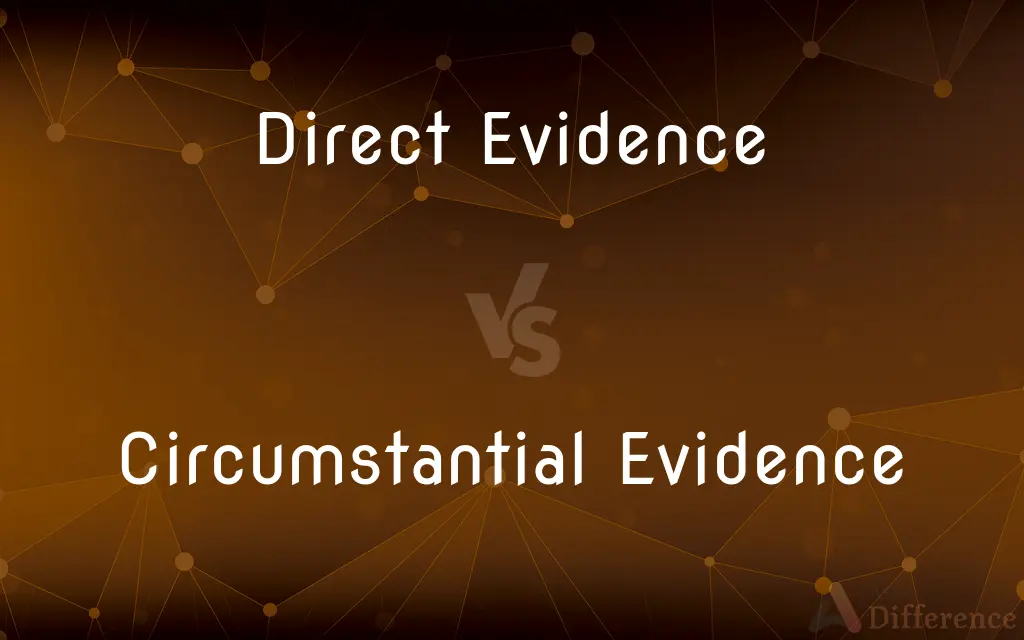Direct Evidence vs. Circumstantial Evidence — What's the Difference?
By Tayyaba Rehman — Published on October 6, 2023
Direct Evidence directly proves a fact without the need for inference, while Circumstantial Evidence implies a fact based on a series of other related facts.

Difference Between Direct Evidence and Circumstantial Evidence
Table of Contents
ADVERTISEMENT
Key Differences
Direct Evidence offers immediate proof of a fact, like a witness testifying they saw a crime happen. In contrast, Circumstantial Evidence suggests a fact but requires interpretation and reasoning, such as finding fingerprints at a crime scene but not witnessing the crime.
Many believe that Direct Evidence is more reliable since it’s straightforward. However, Circumstantial Evidence, although indirect, can be compelling when pieces collectively point to a particular conclusion.
Both Direct Evidence and Circumstantial Evidence are admissible in court. While Direct Evidence can swiftly establish a fact, Circumstantial Evidence requires jurors to make logical connections between the presented facts and the conclusion.
An example of Direct Evidence might be a surveillance video showing a person stealing. Conversely, Circumstantial Evidence could be the person found possessing stolen items without a video of the theft itself.
It's crucial to critically assess both Direct Evidence and Circumstantial Evidence. The former can be falsified or mistaken, while the latter requires logical connections that may not always lead to accurate conclusions.
ADVERTISEMENT
Comparison Chart
Nature
Straightforward proof of fact
Implies a fact based on other facts
Reliability
Often seen as more reliable
Can be compelling if multiple pieces align
Examples
Testimony of an eye-witness
Finding fingerprints without witnessing the crime
Interpretation
Requires little to no interpretation
Requires inference and reasoning
Impact in Court
Can swiftly establish a fact
Jurors must connect presented facts to the desired conclusion
Compare with Definitions
Direct Evidence
A record or documentation verifying an event.
The email trail was Direct Evidence of their agreement.
Circumstantial Evidence
Evidence based on inference and not personal knowledge.
Finding her DNA at the scene was Circumstantial Evidence of her presence.
Direct Evidence
Testimony from a witness who saw the event firsthand.
She provided Direct Evidence by testifying she saw him enter the building.
Circumstantial Evidence
Evidence requiring interpretation to prove a point.
His sudden wealth was Circumstantial Evidence of the alleged bribery.
Direct Evidence
Physical proof that does not require inference.
The surveillance footage served as Direct Evidence of the theft.
Circumstantial Evidence
Indirect facts that, when combined, suggest a conclusion.
The smell of gasoline was Circumstantial Evidence of arson.
Direct Evidence
Evidence that speaks directly to the question at hand without need for interpretation.
His confession was Direct Evidence of his guilt.
Circumstantial Evidence
Proof of a series of facts from which one may infer a principal fact.
The muddy shoes were Circumstantial Evidence that he had been at the park.
Direct Evidence
Demonstrative representation of a fact.
The diagram was used as Direct Evidence to show the scene of the accident.
Circumstantial Evidence
Information or facts that imply something occurred but don’t directly prove it.
His evasive behavior served as Circumstantial Evidence of his involvement.
Common Curiosities
Is Direct Evidence always reliable?
While often straightforward, Direct Evidence can be mistaken or falsified.
What is Direct Evidence?
Direct Evidence directly proves a fact without requiring any inference.
Can Circumstantial Evidence be used in court?
Yes, both Direct and Circumstantial Evidence can be admissible in court.
How about an example of Circumstantial Evidence?
Finding a suspect’s fingerprints at a crime scene without seeing them commit the crime.
Can Circumstantial Evidence alone lead to a conviction?
Yes, if compelling enough and when pieces collectively point to a particular conclusion.
Can Circumstantial Evidence be compelling?
Yes, when multiple pieces of Circumstantial Evidence align, they can be very compelling.
How should jurors treat Circumstantial Evidence?
Jurors should make logical connections between the presented facts and the conclusion.
How is Circumstantial Evidence different from Direct Evidence?
Circumstantial Evidence implies a fact based on a series of other related facts, requiring inference.
What’s an example of Direct Evidence?
A witness testifying they saw a crime occur is Direct Evidence.
Is Direct Evidence more impactful than Circumstantial Evidence?
Not necessarily. While Direct can swiftly establish a fact, strong Circumstantial Evidence can be equally impactful.
What's crucial when evaluating Direct Evidence?
It’s essential to ensure the Direct Evidence is authentic and not mistaken.
Does Circumstantial Evidence always suggest guilt?
No, Circumstantial Evidence can suggest various facts, not just guilt.
Can a case have both Direct and Circumstantial Evidence?
Yes, many cases have a mix of both types of evidence.
Can Direct Evidence be refuted?
Yes, like all evidence, Direct Evidence can be challenged in court.
Why is Circumstantial Evidence sometimes seen as weak?
Because it requires inference, there's potential for varied interpretations, making it seem weaker than Direct Evidence.
Share Your Discovery

Previous Comparison
Price vs. Value
Next Comparison
Did vs. HadAuthor Spotlight
Written by
Tayyaba RehmanTayyaba Rehman is a distinguished writer, currently serving as a primary contributor to askdifference.com. As a researcher in semantics and etymology, Tayyaba's passion for the complexity of languages and their distinctions has found a perfect home on the platform. Tayyaba delves into the intricacies of language, distinguishing between commonly confused words and phrases, thereby providing clarity for readers worldwide.
















































